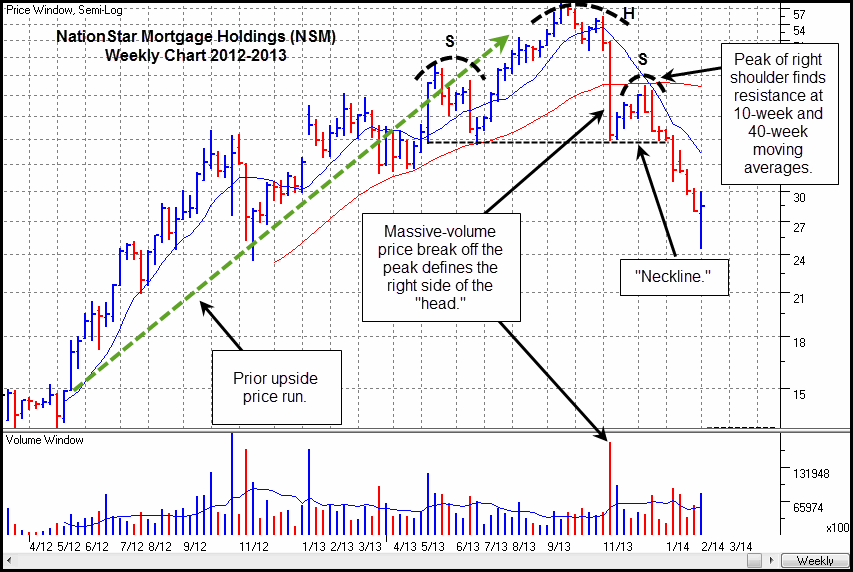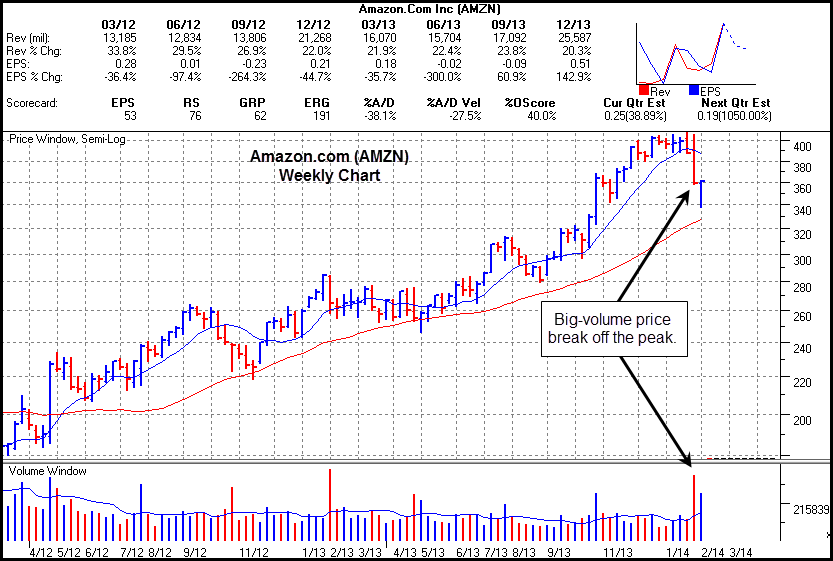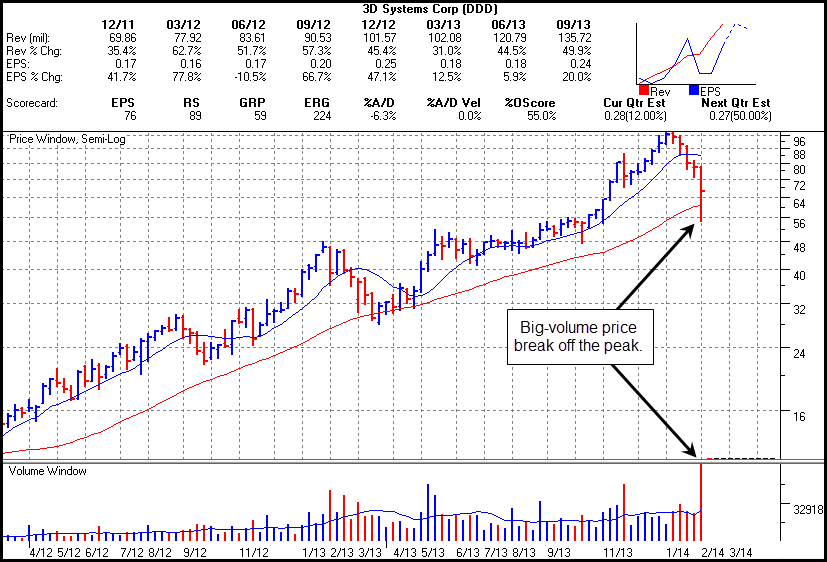Short-Selling For Dummies: Build A Watch List

When the market seas get rough and stocks start to decline we are often asked how we “screen” for short-selling candidates. This is a reasonable question, but the answer is often not what most would-be short-sellers would expect. We are not looking for “overvalued” stocks with high price-to-earnings ratios, or stocks where something fishy can be detected on the company’s financial statements and hence be predictive of a major fall-out in the stock once the fishy smell is exposed as something more substantial. The simple answer is that if you want to find the best short-selling candidates to exploit in the next bear market you needn’t look any further than the current crop of leaders. To understand why this is so, let’s take a step back and look at what we use as our primary short-sale “set-up.”
Most traders and investors who are familiar with basic technical analysis are no doubt familiar with the “head & shoulders” (H&S) top formation, and in our experience this is generally the most reliable topping formation. If you understand the basic mechanics of the “H&S” formation you can also understand why leading stocks, or to be more precise, stocks that were recent leaders, provide the best pool of stocks from which to cull a list of short-sale candidates.
The essential feature of any H&S formation is a sharp price break off the peak that forms the right side of the “head” in the formation, as we can see in Figure 1, the weekly chart of Nationstar Mortgage Holdings (NSM) from 2012 to the present. NSM came public in early March of 2012 and proceeded to have just about a 300% price run from the March 2012 IPO price of $14 to the peak at $57.95 in September 2013. Clearly, during this period NSM was a bona fide market leader. A month off the absolute peak in the stock NSM then had a massive-volume price break off the peak that defined the right side of a potential “head” in what was then still an H&S formation in-the-making.
A short rally formed the right shoulder as the stock found resistance at the confluence of its 10-week and 40-week moving averages, the blue and red moving averages, respectively, on the chart. In most cases this rally provides a short-sale point right at the 10-week moving average or slightly above. I
n the case of NSM we can also see that at that time the 10-week moving average crossed below the 40-week moving average for a so-called “black cross.”

Figure 1 – Nationstar Mortgage Holdings weekly chart, 2012-2013. Chart courtesy of HGS Investor software, ©2014, used by permission.
Once NSM broke down to finish forming its right shoulder, it found temporary support along the “neckline” of the H&S formation before heading lower. This downside “breakout” offered a second short-sale point as the stock pierced the neckline and moved lower. At the time of this writing, NSM is down 50% from its peak of just four months ago.
While the precise mechanics of handling the short side of such a formation are more involved and have filled chapters in our books where we have covered the topic of short-selling, our intention here is to demonstrate how one initially finds short-selling candidates. Leading stocks that have had big upside price moves and then begin to change character as NSM did in the latter part of 2013 as they begin to break down, make your best short-selling candidates.
Thus, many of the stocks that today represent some of the best-performing names on your current buy watch list may transform into your best short-sale candidates once they top. In this manner, developing a list of short-sale candidates is as simple as watching your current list of buy candidates. Once a leading stock starts to break down sharply off its peak on massive-volume, it can be moved to your short-sale watch list as it then will likely try to build a right shoulder, sometimes even two or three right shoulders, in an overall topping process. Examples of leading stocks that may currently be showing the initial “signature” of a top and the eventual process of building an H&S formation at the time of this writing include stocks like Amazon.com (AMZN) and Three-D Systems (DDD), shown in Figures 2 and 3, below.

Figure 2 – Amazon.com (AMZN) weekly chart, 2012-present. Chart courtesy of HGS Investor software, ©2014, used by permission.

Figure 3 –Three-D Systems (DDD) weekly chart, 2012-present. Chart courtesy of HGS Investor software, ©2014, used by permission.
While both of these examples will require more time to fully “ripen” and develop into potential H&S formations, the initial price breaks off the peak are the basic criteria we are looking for to place these on our short-sale watch list. Another main point to keep in mind is that these stocks could recover, build new bases, and set-up for another upside move. In other words, they don’t necessarily have to continue filling out H&S formations and then move lower, but the initial high-volume price break off the peak is always your first sign of a potential top, after which they should be monitored for potential short-sale entry points.
Leading stocks that begin to top are your best short-selling candidates primarily because of the fact that the institutional investors who steadily piled into these leaders, driving them ever higher, will eventually reverse their money flows. This creates a “pile in, pile out” phenomenon as institutional money leaves a leading stock once it has completed its leadership cycle. Thus, if one is intent on building a watch list of short-sale candidates, one need look no further than their current buy watch list as individual names start to change character and break down.
Gil Morales and Dr. Chris Kacher are both principals and managing directors of MoKa Investors LLC and Virtue of Selfish Investing, LLC, cofounders of www.selfishinvesting.com and co-authors of “Trade Like An O’Neil Disciple: How We Made 18,000% in the Stock Market” (Wiley, August, 2010) and their newest book, “In the Trading Cockpit with the O’Neil Disciples,” (Wiley, December 2012). Both are former internal portfolio managers for William O’Neil + Co., Inc., where Dr. Kacher also served as a senior research analyst and co-authored an in-house proprietary book “The Model Book of Greatest Stock Market Winners”, while Mr. Morales also served as Chief Market Strategist, Vice-President and Manager of the firm’s Institutional Services group, and co-authored with William J. O’Neil a book on short-selling, “How to Make Money Selling Stocks Short” (Wiley, 2004).
= = =
RELATED READING
Read the TraderPlanet interview with William J. O’Neil on why growth investing still works.
Read Today’s Top Markets stories here.
We’re social. Join the conversation on TraderPlanet’s Facebook page.


